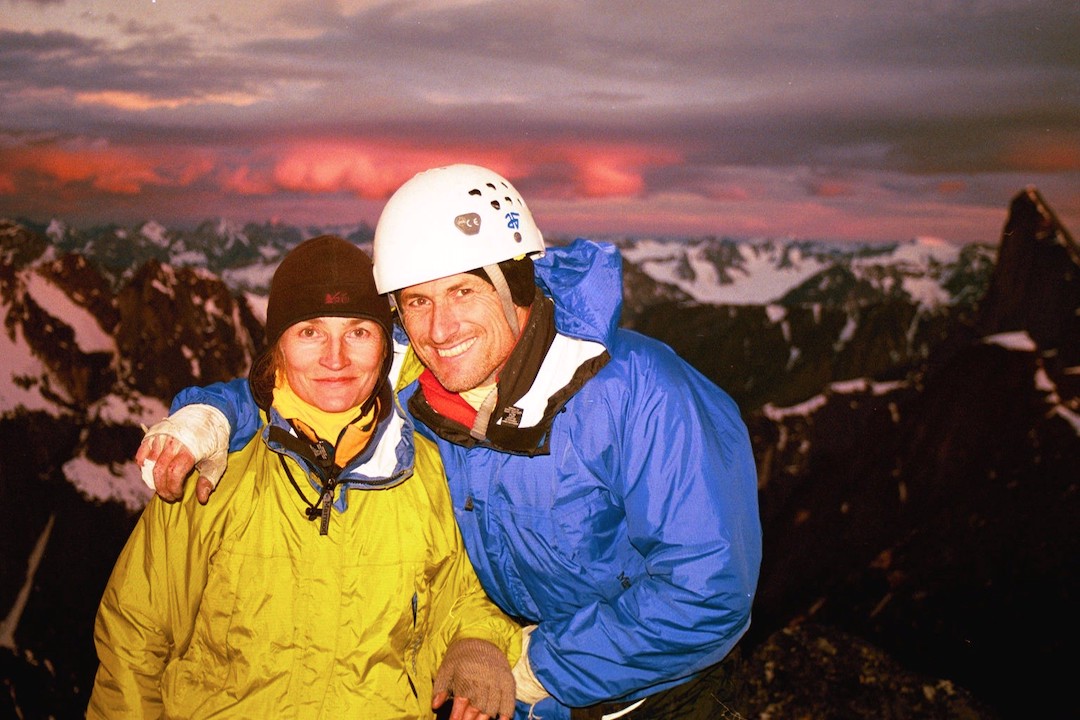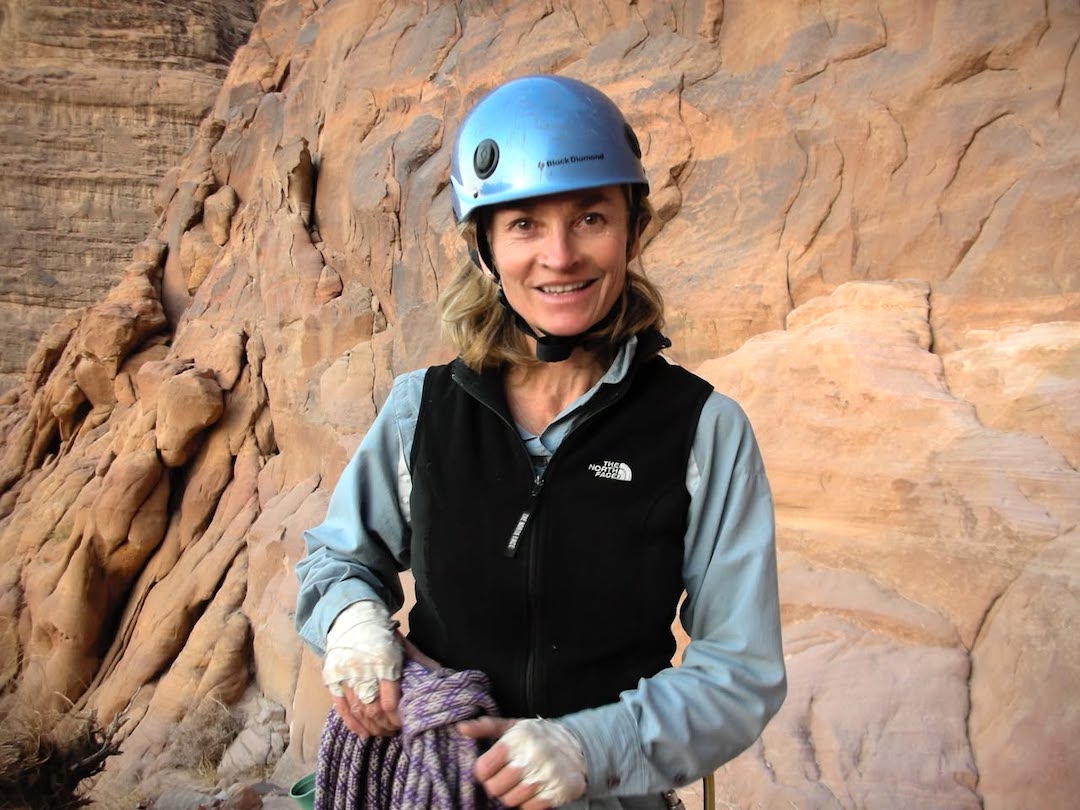Franziska Schawalder Garrett, 1954–2025

James Garrett refers to his wife as “the best climbing partner I've ever had.”
Franziska Schawalder Garrett, who died October 17 at age 70, and her husband had a many-decade adventure-climbing career in a multitude of regions. She maintained a career of equal breadth, as a physician practicing for Intermountain Healthcare (IHC) in Salt Lake City.
Dr. Peter Lenz, a retired emergency physician, posted to a Salt Lake Climbers Alliance page: “Franziska was the physician I always wanted to be: kind, calm, intelligent, well trained, good humored, efficient, and a person who loved her profession, while living a full and rewarding personal life.”
Franziska, who was originally from Bern, Switzerland, and James, whom she met during his mountain travels, pioneered hundreds of routes in their home state of Utah and beyond, intentionally establishing long, moderate, well-protected climbs. They employed a “plaisir” principle, using a Swiss phrase meaning fun and casual, in putting up routes that other people would want to climb.
Among many first ascents the two made in Utah are the very popular 800-foot Black Streak, Devils Castle North Face (III 5.10a/b) in 1986; the 500-foot Till Hell Freezes Over (III 5.11b), Main Hellgate, 1994; the classic 400-foot Scenic Byway (II 5.10a) in the San Rafael Swell, 1992; and the 300-foot Nose Shadow (III 5.11a A0, now free at 5.12c), Ibex, 1996. In Nevada, they put up the 680-foot Stinger (II 5.8), in the Toano Range, and the 445-foot Paiute Pockets (II 5.9), in Paradise Valley, both in 2020.
The new-route tally includes climbs in Switzerland, France, Austria, Italy, Greece, Jordan, Malawi, Ethiopia, Tanzania, Kenya, Namibia, Indonesia, and Borneo, their routes ranging from alpine trad to bolted, with further climbing in other countries.
Franziska had grown up in Bern, the middle of three sisters. As James wrote in an online obituary, her sister Kathrin told him Franziska would run home from school, “excited to do her homework.” She eventually studied medicine at Universität Bern, graduating in 1979.
The couple met in August 1974 in Kanton Wallis, Switzerland. A ski patroller at Big Sky in Montana, James had hitchhiked to New York for a cheap flight to the Alps to climb, ski tour, and hike. In Europe, he ran out of money, he says, “but found a summer camp job in the Wallis where we took teenagers hiking, camping, top-roping, etc.” Franziska, too, was hired as an end-of-season counselor. She was 19 and he 22, and while he had intended to climb Mt. Ararat in Turkey afterward, he moved to Bern, where she returned to her studies. The two married in Switzerland on November 19, 1976, and, as James wrote, then “climbed, skied, and traveled worldwide, living a lovely life of adventure.”
In 1981 they moved to Utah, where Franziska completed a residency at Intermountain Health LDS Hospital and became board-certified in internal medicine in 1984. She was recruited to work in the emerging field of urgent-care clinics, loved the job, and remained in it until 2022, when she was diagnosed with urothelial cancer. Still she traveled internationally, hiked, biked, and climbed until three months before her death.
James was a flight nurse at the University of Utah Hospital Trauma Center, Level 1, who retired in his mid-50s and maintains his RN license for a volunteer phase that has taken him to Haiti post-earthquake, an ICU in Nepal, and on over 20 trips with the Cure Blindness Project.
Two years ago Franziska joined him on a Cure Blindness trip to Eritrea. Per usual for James, the pair paid for themselves, and they bought and contributed equipment. James over the years put up plaisir-type climbs all over Africa, and in 2016 Franziska joined him in re-equipping Beyond Plaisir (12 pitches, III 5.10a/20) in the Spitzkoppe Range of Namibia, creating an inviting climb on a formerly run-out line done by James and Timmy O’Neill, an ophthalmic tech with Cure Blindness. Franziska also repeated some of James’s routes in Ethiopia on the 2023 trip.
Dr. Geoff Tabin, co-founder of the Cure Blindness Project, says of Franziska: “It took her no time to figure out what was needed rather than being a tourist coming along with James. She jumped in and saw where we could improve the care and what to do for emergency issues…. A lot of things were really lacking, and she just stepped in and filled all these holes. She is lovely, joyous, kind, wonderful with every individual, still smiling after a 14-hour day working. They both are just fantastic, never complain, and always work hard.”
Says Timmy, “James would not only assist in bringing sight to these places, but also leave a really cool legacy of climbs that would become really popular and help generate an economy or the ability to be guided. The local climbers could use them.”
Among many online tributes to Franziska is this from another woman doctor: “It is impossible to put into words how much I love and will miss Franzi,” Karen Kelley of Millcreek, Utah, wrote. “From the moment we met in 1989, we became fast friends and shared many adventures together: traveling, camping, climbing, MetOpera, Ballet West, theater, concerts, dinner parties, holidays, working together at Instacare and on the Deer Valley doctors’ ski patrol…. I could never keep up with her, backcountry skiing or hiking. She was like a hummingbird, zooming around so fast—it was no wonder she was so slim despite her voracious appetite. She loved to cook and do many other physical activities: yoga, biking, kayaking.… She had an amazing green thumb, both working in her cherished yard and inside for orchids and amaryllis. She had such a zest for life and wanted to be here longer for her beloved James.
“Franzi had so many friends,” Karen wrote, “but there was always room in her heart for one more.”
Among many climbing partners was the great explorer Fred Beckey. In 1988, after hiking in with Fred, Franziska and James attempted the east face of Wolverine Peak (12,631’), in the remote St. Lawrence Basin of the Wind River Range in Wyoming. As an AAJ report describes this attempt, “James and Franziska spent the night at the top of pitch 5. They climbed two pitches in the morning and then descended. The three of them then climbed the beautiful ridge (complete with a gendarme rappel) on Saddleback’s north face (1,800’, 5.8) the next day.” The group went back to Wolverine twice, adding other strong team members, before James, John Chilton, and Ryan Hokanson completed The Illness (IV 5.10 A3) in 1999. While Franziska deferred on summit day to streamline the process, she was integral in establishing this major line.
Fred Beckey once advised Franziska always to bivy when darkness fell, and she heeded. James says: “We did so many unplanned as well as planned [bivies], it was crazy. She was the bivy queen. She would be sound asleep hanging on a narrow ledge, and I would shiver through the night.
“On Wolverine, she woke up and was ready to continue up.” He praises her as tough, saying, “She often carried a heavier pack than me, and [she] was 116 pounds.”
In the San Rafael Swell in 1995, the two climbed the stellar 400-foot crack climb Weasel on the Run (III 5.11 A0, freed at 5.11c by Seth Shaw and Beth Malloy in 1996), on the first ascent of the Weasel Tower. In 1997 in the same region, James and Franziska made the first ascent of a 300-foot tower they named El Sombrero, via La Piñata (III 5.9 A1+).
In the Wind Rivers in 2006, Franziska and James climbed a 1,300-foot line, Ambush Plaisir (III 5.9), on the Ambush formation. A week later they put up the now much-repeated 1,500-foot Triple Shot (IV 5.7+), tracing three gendarmes to the summit of Ambush.
James, says Timmy O’Neill, “was really elevated by being with Franziska for 50-plus years. It was a partnership in all things.”
—Alison Osius


